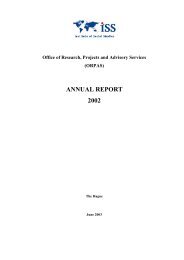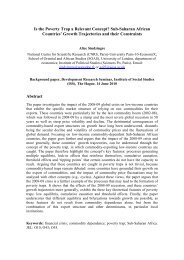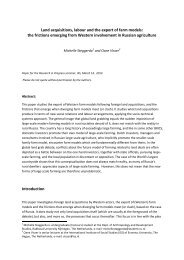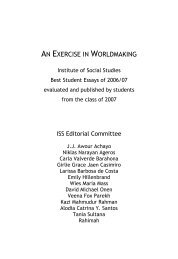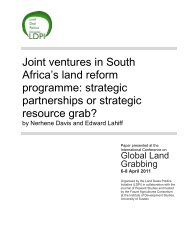AN EXERCISE IN WORLDMAKING 2009 - ISS
AN EXERCISE IN WORLDMAKING 2009 - ISS
AN EXERCISE IN WORLDMAKING 2009 - ISS
You also want an ePaper? Increase the reach of your titles
YUMPU automatically turns print PDFs into web optimized ePapers that Google loves.
11 The Interesting Facts Of The New Trade And Growth Theories 133<br />
convergence of income and the North’s monopoly of power in trade will<br />
be explained below.<br />
As mention before, the North-South model by Findlay (1980) states<br />
that the North is the manufacturing center and the South is the primary<br />
product center which is supported by Sachs and Warner (2001) who find<br />
that the share of natural resources exports in GDP is negatively correlated<br />
with growth, even controlling for changes in the terms of trade. In<br />
a similar vein, Glyfason (2001) finds that natural resources wealth undermines<br />
growth, stressing the impact of natural resources abundance on<br />
educational expenditure and attainment. Moreover, the North and South<br />
have asymmetric engines of growth. The North’s engine is internal, with<br />
its own rate of capital accumulation, while the South’s engine is external,<br />
with its exports of primary products to the North. When the North is on<br />
an upswing, it imports more of the South’s goods generating higher rates<br />
of growth in the South; when the North is on a downswing; it transmits<br />
recession to the South by reducing its demand for Southern exports. It is<br />
a model of unidirectional dependency (Darity and Davis 2003). Mayer<br />
(1996:10) also explains that the process of convergence may be retarded<br />
because in developing countries a large part of income needs to be spent<br />
to satisfy basic needs and is therefore not available for investment.<br />
The second model built by Krugman (1979) implies that the growth<br />
rate of a region is positively related with its own capital stock and negatively<br />
related with other region’s accumulated stock. The North, historically,<br />
has higher stock of capital from colonial accumulation. The free<br />
trade will lead to uneven development while the North will grow faster<br />
in manufacturing sector than the South. When the North reaches the<br />
upper limit, the South’s manufacturing sector can shoot to zero causing<br />
manufacturing to disappear in the South to fully specialize in agricultural<br />
sector. Here, the de-industrialization occurs. Stokey who also developed<br />
a so called North-South trade model confirms that based on vertical<br />
product differentiation and international differences in capital quality, the<br />
South produces a low quality spectrum of goods; and the North, a high<br />
quality spectrum. If human capital is acquired through learning by doing<br />
and is stimulated by the production of high quality goods, free trade will<br />
speed up human capital accumulation in the North and slow it down in<br />
the South. The country that begins with a technological lead tends to<br />
widen the lead over time (Bardhan and Udry 1999: 190). These arguments<br />
are supported by Aghion and Durlauf (2007) who state that coun-




